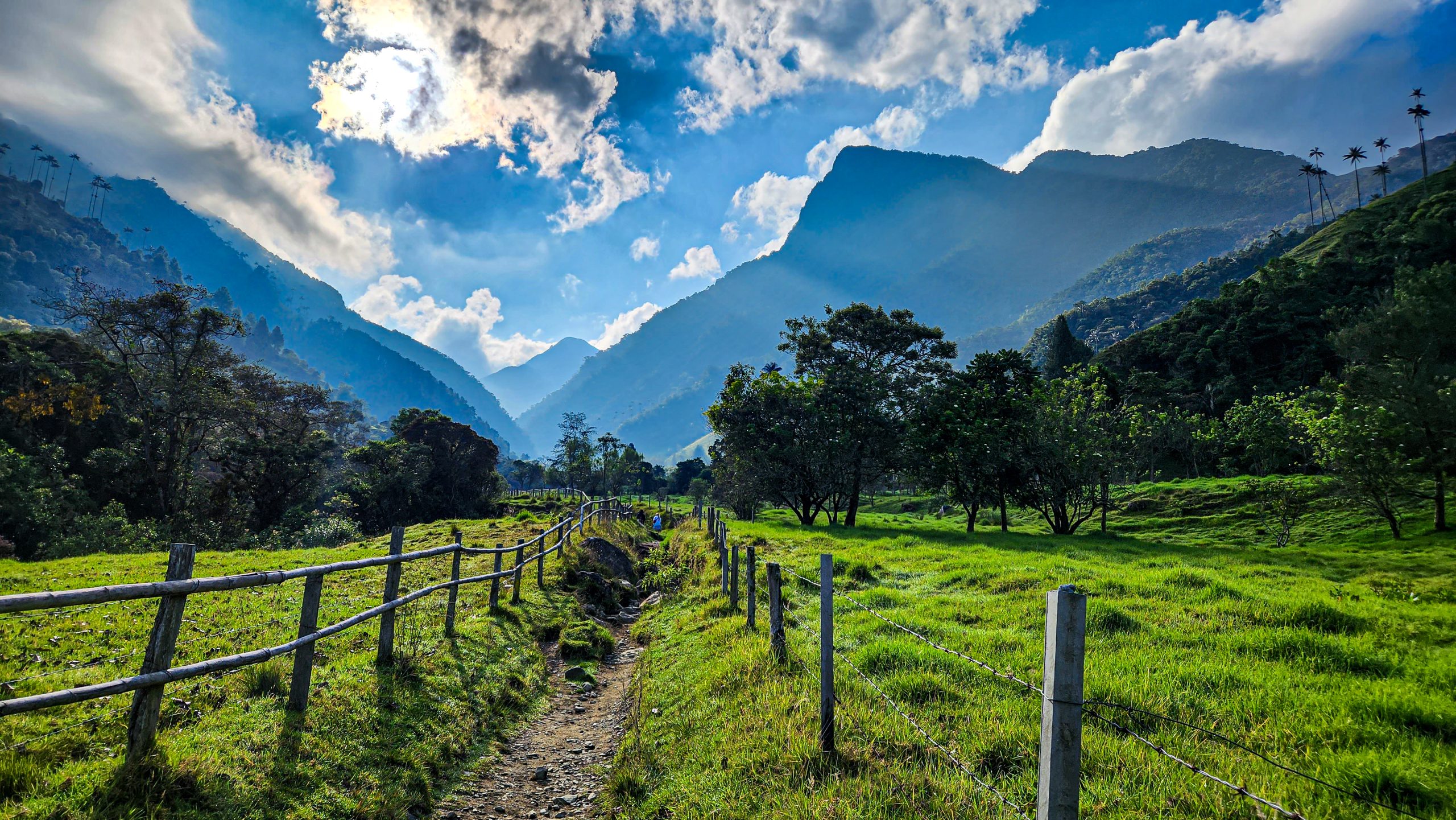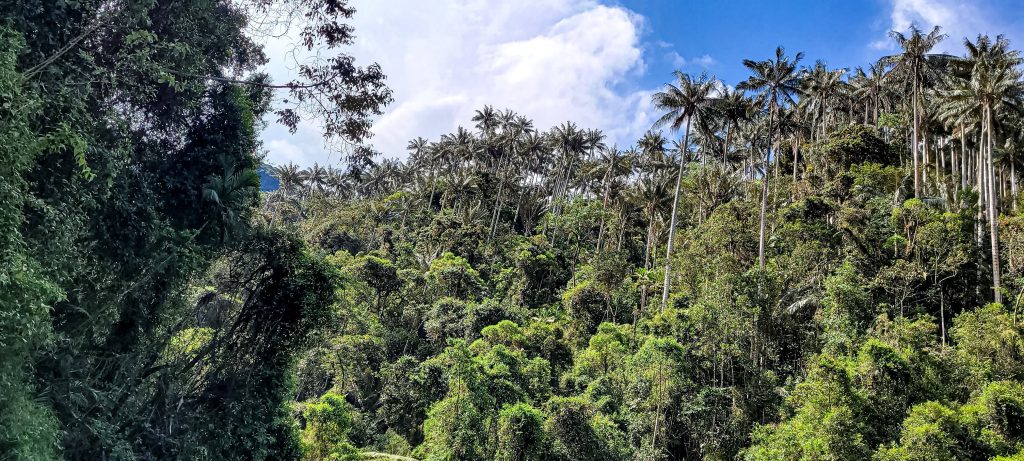
Dreaming of spotting vibrant tanagers, majestic condors, or elusive endemic species? The Central and Western Andes of Colombia offer incredible birding opportunities for everyone, from beginners to seasoned experts and photographers. These five locations are perfect for those who enjoy hiking and exploring nature trails.
1. Salento, Colombia
Salento, renowned for its charming architecture, is also a birding haven. This picturesque town is the gateway to three major hotspots teeming with unique and sought-after species, including some Colombian endemics.
Cocora Valley
Just a 25-minute drive from Salento, Cocora Valley is home to the world’s tallest palm trees, the iconic Wax Palms (Colombia’s national tree). This stunning natural park features diverse trails, varying in difficulty and length, and offers the potential to spot the majestic Andean Condor – an endangered species with few reliable viewing locations, making Cocora Valley a truly special place. Keep an eye out for an adult male that frequents the area. Beyond condors, you’ll find a variety of other birds, including Mountain Tanagers, Mountain Toucans, Eagles, Hawks, Hummingbirds, and Trogons. The highlight for many is encountering mixed-species flocks – a breathtaking experience where numerous bird species join forces, creating a whirlwind of activity as they forage and protect themselves together. That’s a challenge if you can take a good decent photo of at least two birds when encounter these flocks! 🙂
You can explore this place solo, but for a truly rewarding birding experience, hire a guide. Their knowledge of the area, expertise and keen eyes will reveal birds you’d likely miss. If hiking alone, thoroughly research the available trails, carry maps and location devices, and be aware that some trails involve challenging, potentially endless, mountain climbs.
La Carbonera
This remote nature area, known as the “Sanctuary of the Wax Palms,” boasts a vast, well-preserved forest with an estimated 400,000+ wax palms. Accessing La Carbonera is an adventure in itself! A “birding safari” by Jeep takes you from 2,000 to 3,360 meters above sea level along the national road. Multiple stops at promising birding locations allow for walks and breathtaking views of canyons and valleys. The star of the show here is the endemic Yellow-Eared Parrot, but you can also spot Mountain Toucans, Mountain Tanagers, Chlorophonias, Woodpeckers, Hummingbirds, and other Parrot species. Mixed-species flocks are also common here. You can take walks along the path but you can also hike underneath the big palm trees, once you reach to “La Ceja” the place where we find the house of La Carbonera.
To fully experience this route, including the palm sanctuary forest, hiring a jeep driver and experienced birding guide is mandatory. Independent hiking within the forest is strongly cautioned against due to potential disorientation. Moreover, there is a very difficult path of 30KM each way from Salento to La Carbonera, underscoring the necessity of professional guidance. These professionals ensure both your safety and a rewarding birding adventure.
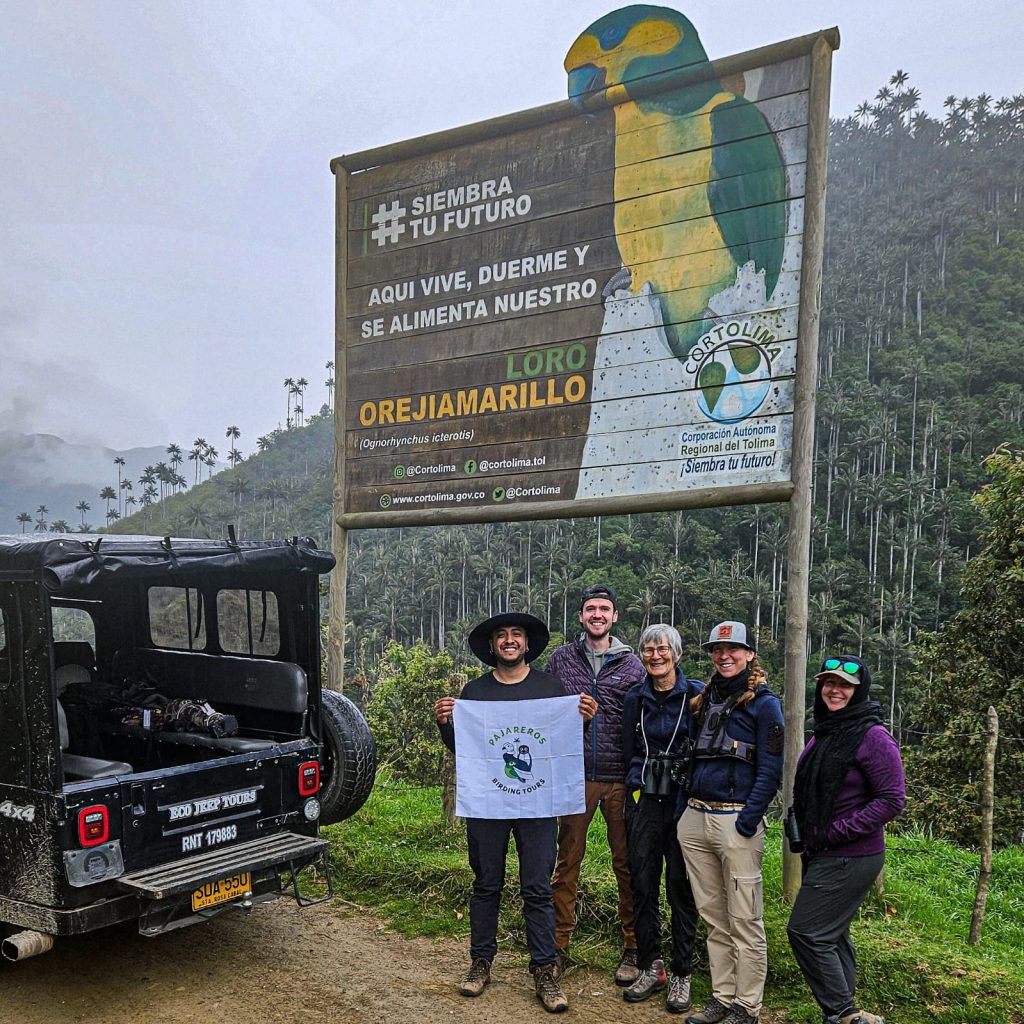
Santa Rita Nature Reserve
Nestled at the bottom of Salento, at 1,700 meters above sea level, this former cattle ranch, now transitioning into a vital nature reserve, boasts important water sources including waterfalls and pristine creeks that enhance its scenic trails. Its large forest, interconnected with the Otún-Quimbaya Flora and Fauna Sanctuary, establishes it as a premier birding destination. While the route is generally safe for independent exploration, hiring a local guide is highly recommended. These guides possess invaluable knowledge of bird calls and behaviors, greatly increasing your chances of spotting the reserve’s diverse avian inhabitants, which include five Colombian endemics: the Multicolor Tanager, Crested Ant-tanager, Grayish Piculet, and Parker’s Antbird, as well as exciting sightings like the White-capped Dipper, Red-ruffed Fruitcrow, and the spectacular Torrent Duck.
2. Manizales, Caldas
Nestled amidst the majestic Andean mountains, Manizales, the ‘City of Open Doors’, is a birding paradise. Its unique location, surrounded by lush cloud forests and coffee plantations, provides access to a wealth of nature reserves and former cattle ranches now dedicated to conservation. This abundance of hotspots offers exceptional birding opportunities for photographers, hikers, and nature enthusiasts alike, who seek to immerse themselves in the region’s rich biodiversity and explore the vibrant birdlife that thrives within its diverse ecosystems. Here I explain about some of the important places to visit.
Nevado del Ruiz
The slopes of Nevado del Ruiz, near Manizales, offer a breathtaking tapestry of biodiversity. This vital ecosystem supports a remarkable array of bird species, and the Páramo, a unique and essential habitat, provides crucial water resources for the region. Discover Laguna Negra, a mystical lagoon born from glacial and volcanic forces. Birding here is an unforgettable experience, with sightings of the Andean Duck, the endemic Buffy Helmetcrest, the elusive Many-striped Canastero, the energetic Andean Tit-tail, and a dazzling variety of hummingbirds and tanagers, including the Great Sapphirewing, Buff-winged Starfrontlet, Shining Sunbeam, and the vibrant Hooded and Scarlet Mountain Tanagers.
Exploring Nevado del Ruiz’s diverse habitats necessitates a vehicle and driver. While independent exploration is feasible, a knowledgeable local guide elevates the experience, offering invaluable bird identification skills and ensuring safe navigation. For those drawn to the dramatic landscapes of “Valle de las Tumbas,” a guide is mandatory beyond the park entrance. This high-altitude route, celebrated as one of Colombia’s most spectacular, climbs to 4,150 meters. Prior acclimatization is crucial to prevent altitude sickness. Pack layers of warm, waterproof clothing to combat the area’s frequently cold, windy, and rainy conditions.
Rio Blanco Nature Reserve
Situated in the rural landscape surrounding Manizales, this nature reserve plays a crucial role in global nature and water conservation. Its 4,932-hectare expanse of pristine Andean cloud forest, ranging from 2,150 to 3,700 meters above sea level, supports an extraordinary array of biodiversity, making it one of the most biodiverse regions on Earth. Bird enthusiasts will be captivated by the abundance of avian life, including mountain tanagers, toucans, and trogons. The frequent appearance of mixed-species flocks provides a truly immersive and dynamic wildlife experience. Due to the reserve’s extensive size and intricate network of trails, a local guide is mandatory to ensure safety and enhance your exploration. A driver is also highly recommended for efficient transportation within the area. Given the potential for cool temperatures and rainfall, layered clothing and waterproof outerwear are essential.
Feeders, Farms and Nature Reserves
Manizales, a region steeped in natural beauty, boasts a remarkable network of conservation areas, transforming former agricultural lands into thriving ecosystems. This dedication to preservation has fostered a haven for birdlife, attracting both nature enthusiasts and avid photographers. From former cattle ranches and coffee farms to established thermal springs, each location offers a unique glimpse into the Andean cloud forest and its avian inhabitants.
Pioneering this transformation, Tinamú Birding, once a coffee and plantain farm, now flourishes as an ecolodge, showcasing the remarkable recovery of native Andean forest. It shelters diverse species, including the elusive Little Tinamou, nocturnal owls, and vibrant tanagers and manakins. Similarly, Hacienda el Bosque, a family cattle ranch, has embraced conservation, protecting the high Andean forest. Its feeders provide a rare opportunity to photograph the Gray-breasted Mountain Toucan, alongside fruit-eaters and the striking Crescent-faced Antpitta. El color de mis rêves, a family-driven project, exemplifies sustainable development by converting former pastureland into a flourishing nature reserve and ecolodge. Here, the feeders attract Black-billed Mountain Toucans, Emerald Toucanets, woodpeckers, jays, and a dazzling array of hummingbirds.
Finally, Termales del Ruiz, with its rich history dating back to a time when glacial ski slopes graced its grounds, now seamlessly blends tourism with conservation. The hotel and hot springs, fed by the volcanic landscape, maintain meticulously kept gardens and feeders, offering the unforgettable experience of hand-feeding hummingbirds.
These diverse locations, all accessible with a hired driver or guided tour, provide exceptional birding and photography opportunities. Whether you choose to explore independently or through organized tours, prepare for the cool, windy, and often rainy conditions characteristic of the high Andean cloud forest. Lodging and meals are readily available at each site, ensuring a comfortable and immersive experience in Manizales’ vibrant natural world.
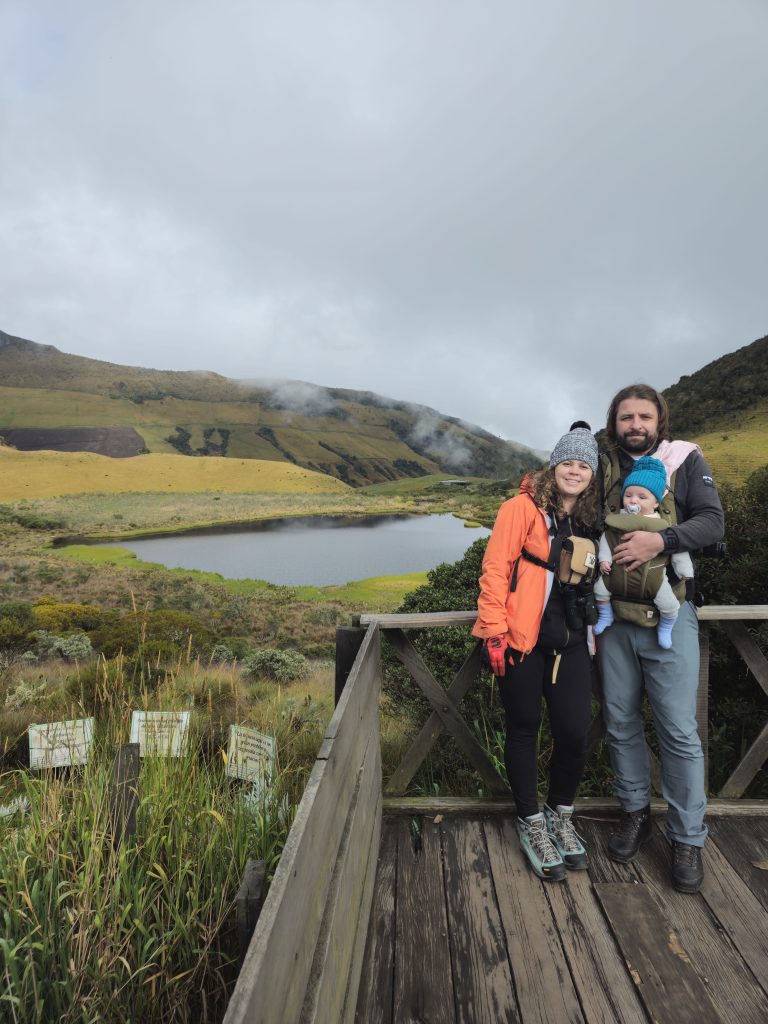
3. Cali
Beyond its reputation as Colombia’s salsa heart and a major urban center, Cali is a gateway to stunning natural wonders. Situated in the fertile Cauca Valley, and surrounded by the Western and Central Andes, the region’s diverse landscapes support a rich tapestry of life. With over +700 bird species recorded in Cali and its surrounding areas, it’s an exceptional destination for birdwatching and exploring the natural beauty of Colombia. If you’re looking for exceptional birding opportunities near Cali, consider San Cipriano and Laguna de Sonso.
San Cipriano Nature Reserve
San Cipriano, in particular, holds a special place in my heart. Beyond its incredible birdlife, it’s a haven of natural beauty. Nestled within the biodiverse Chocó biogeographical region, this reserve offers a complete sensory experience: warm tropical air, refreshing river swims, and the tantalizing aroma of local cuisine. While hotels can arrange entry, navigating the dense forest and locating specific birds like the Red-headed Manakin, Red-faced Parrot, or night birds like Chocó Screech-Owl, Chocó Poorwhil and Crested Owl requires specialized knowledge. Without a skilled guide, even seasoned Colombian birders may only record a fraction of the potential species. For a truly rewarding birding adventure, partnering with a local tour operator is essential.
Laguna de Sonso Nature Reserve
Located in the inter-andean valley of Cauca, near Buga, Colombia, we find the largest remaining natural wetland, a vital ecosystem for diverse wildlife, especially birds. It has been recognized as an Important Bird Area (IBA) by BirdLife International and a Ramsar Wetland of International Importance, it serves as a crucial migratory bird stopover, attracting global birdwatchers, with facilities like the “Buitre de Ciénaga” Environmental Education Center enhancing visitor experiences. Historically, the local families relied heavily on fishing, but today, many are transitioning to birdwatching and ecolodging, promoting conservation, while some continue fishing, highlighting the area’s importance to the community. This shift is vital, as Laguna de Sonso represents a critical remnant of the region’s dry forest, which has been significantly deforested for agriculture, making its preservation essential for both local livelihoods and ecological balance.
To truly experience Laguna de Sonso’s birdlife from Cali, consider a local tour package. While a driver can get you there, local guides provide invaluable expertise. They’ll take you on boat trips along the Cauca River, revealing hidden birdlife like Horned Screamers, Whistling Ducks, and Cardinals. Plus, they know the precise locations where migratory Nightjars gather each year.
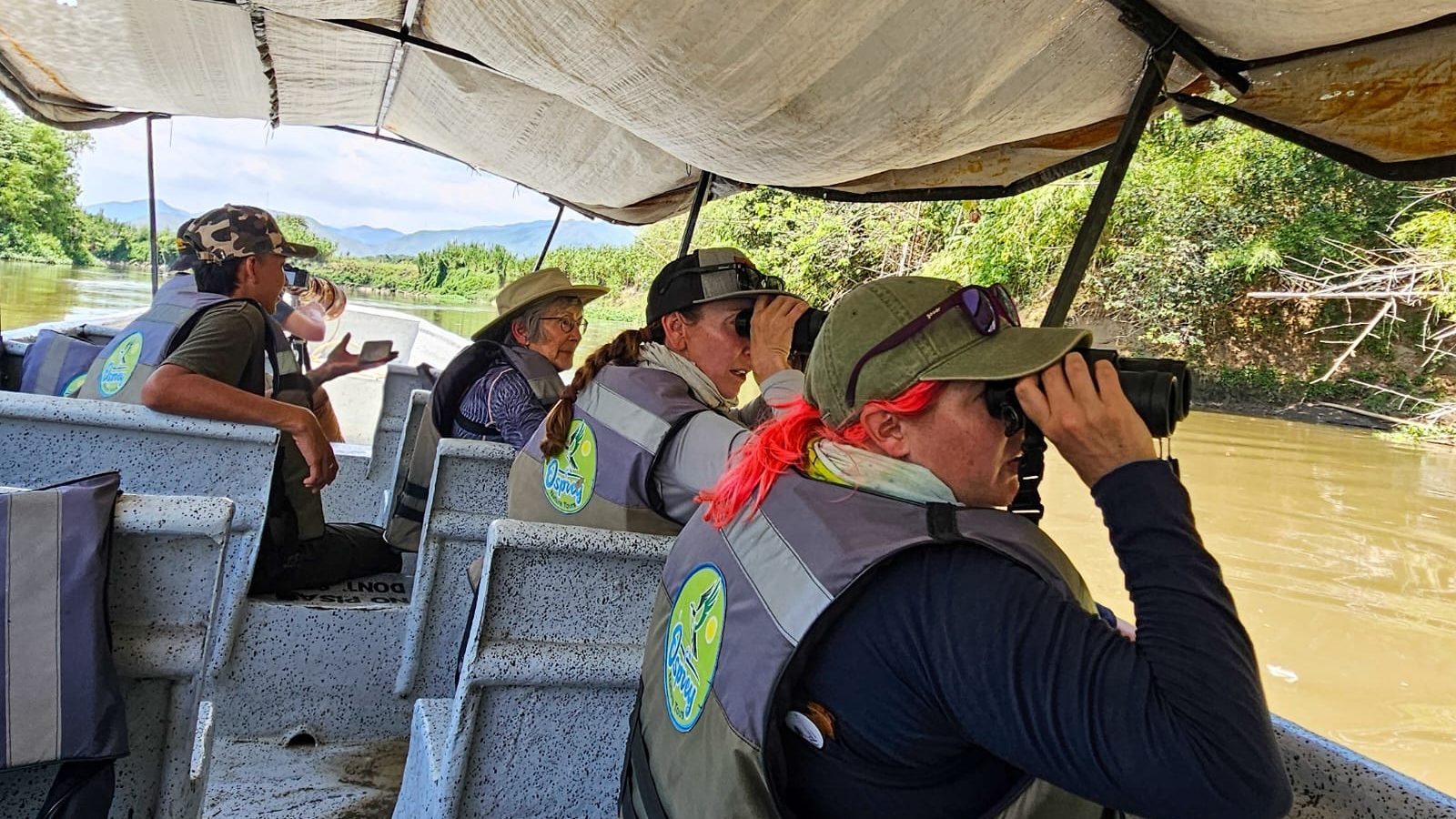
4. Pereira, Risaralda
Pereira, the heart of Colombia’s Eje Cafetero (Coffee Axis) alongside Armenia and Manizales, is a must-visit for coffee lovers. Beyond its bustling city, nature beckons. Just a short distance away lies the Otún-Quimbaya Flora and Fauna Sanctuary, a vital section of the Andean forest bordering Los Nevados National Park. While the park offers accessible trails and guided tours from its visitor center, for serious birdwatchers, venturing further up the mountain is key. Local guides can lead you to prime spots for encountering diverse species, including the vibrant Multicolor and Saffron-crowned Tanagers, elusive Antpittas, the striking Andean Cock-of-the-Rock, and even Howler Monkeys. Choose between exploring the park’s established trails or embarking on a guided adventure deeper into the wilderness.
5. Jardín, Antioquia
Jardín, Antioquia, is a little town located to the south of Medellin, renowned birdwatching destination in Colombia, offering opportunities to see a variety of spectacular birds, including the iconic Andean Cock-of-the-rock and the endangered Yellow-eared Parrot. There are two prime locations that you must visit:
Reserva Natural Jardin de Rocas
This private reserve, nestled in the heart of town and dedicated to nature conservation and research, is a prime location for observing the Andean Cock-of-the-rock. Its famous ‘lek’ provides an unparalleled opportunity to witness their captivating courtship displays. But not only this, you can keep an eye out for three other notable residents: the endemic Crested Ant-tanager, Red-bellied Grackle, and Colombian Chachalaca. ou’ll find this location very easy to reach, making it perfect for independent exploration. And do not forget to make a reservation to ensure your entry, especially during busy periods.
Ventanas Road
Ventanas Road, the route between Jardín and Riosucio, is a crucial habitat for the endangered Yellow-eared Parrot, nestled within humid montane forests, making it a “hardcore” birding destination best explored with a local guide who possesses essential expertise for navigating the terrain and maximizing sightings.
Which of these destinations excites you the most to explore? Which bird species are you most hoping to see? Tell us in the comments!
If you’re seeking a personalized birdwatching experience guided by local experts with extensive knowledge of specific regions or bird species, don’t hesitate to contact us. At Pajareros Birding Tours we’re ready to help you plan your next adventure! Reach out to WhatsApp +573160834407 or send us an email info@pajarerosbirdingtours.com

